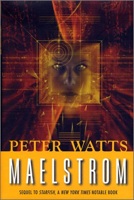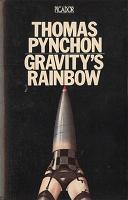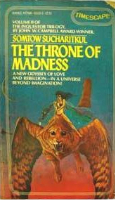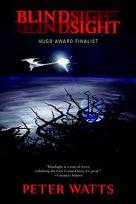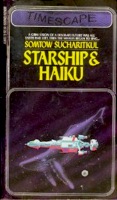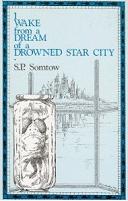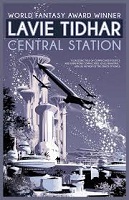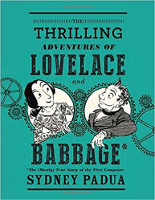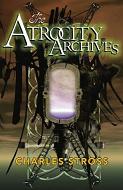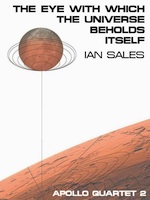 The Eye With Which The Universe Beholds Itself is the second Novella in Ian Sales’ Apollo Quartet, and was originally published in 2012. The third book in the series – Then Will The Great Ocean Wash Deep Above (he has a flair for wordy titles, doesn’t he just!) - is also languishing on my reading pile (hopefully not much longer), whilst the final book, titled All That Outer Space Allows, is scheduled to come out in 2015, and has been announced to be of full Novel length.
The Eye With Which The Universe Beholds Itself is the second Novella in Ian Sales’ Apollo Quartet, and was originally published in 2012. The third book in the series – Then Will The Great Ocean Wash Deep Above (he has a flair for wordy titles, doesn’t he just!) - is also languishing on my reading pile (hopefully not much longer), whilst the final book, titled All That Outer Space Allows, is scheduled to come out in 2015, and has been announced to be of full Novel length.
Ian Sales is a British writer, editor, blogger, and now publisher. Adrift on the Sea of Rains (the first, BSFA award-winning book in the series) was the first book published on his own Whippleshield Books imprint (he is expanding beyond his own writing now, so this is definitely not a vanity setup).
The book kicks off with a Shelley quote, which gives/gave it its title, which I found very apposite, all the more so as it is from “Hymn of Apollo”! And then we dive into another story built around a diverging timeline of events, based on the American Apollo programme. This time the premise changes earlier than in the first book; so these are clearly not part of the same universe - I would actually expect each of these books to stand on their own, and only be linked by being extrapolations of the original Apollo programme. And by their structure, of course. Anyway, in The Eye With Which The Universe Beholds Itself the back story diverges from what we know as our history between Apollo 10 & 11 - the Russians landed a man on the Moon (which means that the divergence on the Russian side must have been earlier to allow this), whilst Neil Armstrong in Apollo 11 aborted the descent and landing due to the persistent 1202 error he kept receiving (instead of ignoring it, as has happened in our time line). After the cancellation of the Apollo programme the Americans then re-focused their efforts to getting an Astronaut to Mars, which they achieved with Ares 9 (using re-tooled Apollo hardware - this is realistic!). The landing area was in the Cydonia region, famous in conspiracy circles for its Face, its Ruins, and its Pyramid. But what Commander Elliot finds there changes history, eventually changes the technology humanity has available for space flight, and of course proves that the conspiracy theorists were right all along (except that all this is top secret, and everything is being denied officially).
I’m not going to spill or spoil more of the story, this is very much worth reading yourself. The book is structured very much like the first one (and I would expect the next two to be very similar, too), inasmuch as you get the following:
A list of abbreviation - clearly based on the original, NASA ones, with some story-specific extensions (and, unless you’re even more of a Space Anorak than me, you will refer back to this occasionally).
The actual story, with every chapter starting with the year it’s taking place in to put it on the timeline, as the story is not told chronologically
A glossary, outlining space missions, names of crew, call signs and other details - starting with known historical ones, and then branching out into where things developed differently here. This is actually not just an addendum, but an essential part of the actual story, as it displays the background to the universe the story plays in, as well as background to some of the protagonists.
A Coda - projected into the far future, based on what the story describes
Bibliography - I have not checked this for any fictional Easter Eggs, but would expect it to be mostly if not wholly correct and rooted in our reality
A list of online sources - again, it looks realistic, but comes with the same caveat…
There were two things which struck me about the story - firstly, I’m even now, after repeated re-reading, not sure if it's making a very clever play on FTL travel and Quantum Theory, or if he’s using Quantum Theory to actually point out that FTL is really not possible; the other one was how much one of the threads resembled Mary Robinette Kowal’s Hugo winning short story The Lady Astronaut of Mars. I think Sales’ story is older, and no, I don’t think Kowal was cribbing, but given that I read the two more or less back to back the similarity in motivation and some elements of the story was striking. And, in my opinion, Sales’s story is better (and I _do_ like the Kowal one!).
Why should you read this? Well, my 2 cents (er, pennies?) would be that it’s very clever, and hugely entertaining. It is very well written, rather complex for it’s length, and shows a massive knowledge and respect for the history (and some people would say high point) of human space flight so far. It is essentially Hard SF, with the exception (like its predecessor) of one ‘magic’ alien device. It is SF which, as one of his fellow writers pointed, out, still boldly goes, in contrast to much of the current output in the genre. The Right Stuff, indeed.
Compelling reading, from one of the new voices in UK SF I would like to hear more of!
More Ian Sales
Title: The Eye With Which The Universe Beholds Itself
Series: Apollo Quartet
Series Number: 2
Author: Ian Sales
Reviewer: Markus
Reviewer URL: http://thierstein.net
Publisher: Whippleshield Books
Publisher URL: http://www.whippleshieldsbooks.com
Publication Date: 2012
Review Date: 140825
ISBN:9780957188341
Price: GBP 6.99
Pages: 78
Format: Hardback
Topic: Alternative History
Topic: Science Fiction
